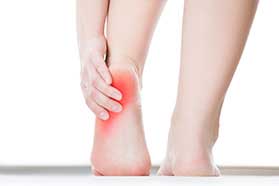Heel Pain Treatment in Richardson, TX

What is Heel Pain?
The heel bone is the largest of the 26 bones in the human foot and is responsible for absorbing physical stresses to the foot from daily activities. Though the heel bone is built to handle the rigors of daily life, too much stress over long periods of time can result in injury - especially if a person has poor foot mechanics or wears ill-fitting shoes.
Early intervention is key when it comes to treating heel pain. It's important to know the difference between actual pain and just being sore, because the symptoms can be similar. A sore heel will usually get better with time, but if the pain continues, it may be time to visit a podiatrist before it becomes a more serious condition.
Causes of Heel Pain
Heel pain has many causes, but it can usually be traced to walking gait abnormalities that add too much stress and pressure on the heel bone and the soft tissues that attach to it. Other causes of stress on the foot include injury, ill-fitting footwear and poor overall health.
Patients typically notice their heel pain when they first wake up in the morning or after strenuous physical activity. Conditions that cause heel pain generally manifest beneath the heel or cause pain behind the heel. If the pain is emanating from under the heel, it is likely the result of a condition that causes inflammation on the bottom of the foot. Pain behind the heel is often an indication of inflammation in the area where the Achilles tendon inserts into the heel bone.
The most common foot conditions that cause heel pain include:
- Plantar fasciitis : As the most common cause of heel pain, this condition occurs when the Achilles tendon becomes inflamed.
- Heel spurs: These are either a small bony growth or a collection of bony growths on the back or underside of the heel.
- Excessive pronation: Pronation is the normal flexible motion and flattening of the arch of the foot that allows it to adapt to ground surfaces and absorb shock.
- Achilles tendonitis : The tendon that connects the back of your leg to your heel becomes swollen and painful.
There are numerous other causes of heel pain, such as rheumatoid arthritis, bone bruises or peroneal tendon tear, but they are not as common and are more difficult to diagnose.
Diagnosis and Treatment of Heel Pain
Gathering a comprehensive patient history is essential to determining the cause of heel pain. Foot mechanics are typically passed down through genetics, so learning family history is important when it comes to making a proper diagnosis. There are so many possible causes of heel pain that your doctor must consider many causes prior to coming to a conclusion about the source of your heel pain.
A physical exam of the affected foot will also be conducted to pinpoint the origin of the heel pain. The doctor will examine the heel while looking and feeling for signs of tenderness and swelling. Once the physical exam is complete, you may be asked to walk, stand on one foot or do other physical tests that help your doctor pinpoint the location of your heel pain.
Treatment of heel pain depends on the condition causing it. Ice, stretching, over-the-counter arch supports and anti-inflammatory drugs are all quick ways to relieve pain, but they will not treat the underlying condition causing the pain. Professional podiatric care for heel pain includes splint therapy, physical therapy , custom foot orthotics and various surgical procedures.
Request more information about heel pain treatment today. Call (817) 203-2760 or contact The New You Medical & Infusion Clinic online.
The New You Medical & Infusion Clinic
Address
100 Grapevine HwyHurst, TX 76054
(817) 203-2760
https://www.newyoumedclinic.com/
Hours
Mon:
10:00 am - 6:00 pm
Tue:
10:00 am - 6:00 pm
Wed:
10:00 am - 6:00 pm
Thu:
10:00 am - 6:00 pm
Fri:
Closed
Sat:
Closed
Sun:
Closed

